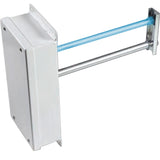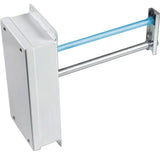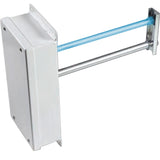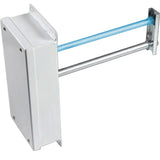How Ultraviolet Germicidal Light Can Fight Bioterrorism
Posted by Nick on for ProLampSales
Over the last 6-8 months, the use of ultraviolet germicidal irradiation to combat pathogens, specifically COVID-19, has skyrocketed in popularity. Many homeowners, businesses, schools, and government institutions have purchased UV disinfection devices for air, surface, and water sanitation. But while COVID-19 has been an unintentional pandemic, the risk for bioterrorism using a transmissible pathogen has existed for decades.
There are hundreds of bacteria, viruses, mold, and fungi that cause adverse reactions in humans and animals. Only a handful of them would work as a biological weapon. The rest are infeasible as weapon agents for a number of reasons. But commercial and institutional building managers should be aware of how to combat the risks that do exist.
Methods of Transmission
Intentional and unintentional spread of harmful pathogens can occur in the air, on surfaces, and in water. Once a human or animal is infected, then vector-borne transmission becomes an additional threat.
A biological weapon can harm or kill substantial numbers of humans, domestic animals, cattle and livestock, crops, vegetation, and agricultural products. While we may think of large commercial buildings or enclosed spaces as high-risk areas to humans, industrial facilities for animals and plants can also present risks that can then be transferred to humans or present an attack on supply chains and the economy.
Risks of Bioweapons
Thankfully, while many types pathogens cause harm to humans, animals, and plants, few of them would make an effective weapon. It is the pathogens that have the ability to cause disease (pathogenicity), are lethal, and are easy to spread that pose the greatest danger.
This is why governments and research labs spend time and resources researching diseases like anthrax, influenza, smallpox, and other highly contagious and lethal pathogens.
There are also various strains of microbes, some more virulent than others, and the virulent strains are the most dangerous, although milder strains may be selected for weaponization if they are easier to spread with a delivery device.
Delivery devices can include aerosolization systems and slow-detonating explosive devices, although the type of device has to be tailored to the spread and survivability of the pathogens.
Non-lethal powder or particles may be utilized to make the harmful pathogen easier to spread. This can result in clumping of the organic and non-organic matter, which can make it more or less difficult to filter out and deactivate the substance.
Defense of Buildings
Pre-pandemic, large commercial office buildings, shopping centers, and institutional buildings contained the most numbers of people in an enclosed environment. If businesses reopen and the trend towards remote working reverses, these large buildings will continue to be at the highest risk for being targeted for attack.
Areas of Risk
There are several methods of introducing a pathogen into a building.
Outside air intakes - the outside air intakes present the greatest risk, as introduction of a bioweapon here can quickly and evenly spread throughout the entire building. This method does not even require the human to enter the building to sabotage it.
Internal ductwork or air handling equipment - while the outside air intakes are the greatest threat, internal ductwork and air handling equipment also present high-risk areas. It may take longer for pathogens introduced this way to spread throughout the building, but the effect is the same over time.
Release inside building - an easily visualized fear is a bioterrorist walking into a building and releasing a pathogen. This would result in a high concentration of biomatter in the lobby or other room the weapon is activated in, creating an initial concentrated danger zone. However, it would take much longer this way for the biomaterial to make its way throughout the building's ventilation system, so is less of an overall threat than direct detonation in the air handling system.
Managing Risk
UV + MERV
Knowing these risks, building managers can utilize a combination of ultraviolet light bulbs and MERV (Minimum Efficiency Reporting Value) filters. This combination has been found to be highly effective removing harmful material and deactivating microbes before they have the chance to spread through a building.
A MERV filter rated 11-15 can remove larger particles, including clumps of organic and inorganic material released from the bioweapon, as well as large organic mold and fungal spores. MERV-13 ratings should be the minimum, especially for larger buildings like commercial offices or schools.
Filters are the first line of defense in a building's air handling system, and a UV germicidal fixture can be employed to deactivate viruses, bacteria, and other microbes that enter the ventilation that are too small for the filter to catch.
HEPA Filtration
HEPA filters could also be used and are as effective as UV + MERV, but it is often cost-prohibitive to retrofit an HVAC system for HEPA filters if they are not initially installed. Also, if UV + MERV filters are used, there is little additional benefit from a HEPA filter.
If installing HEPA filters, the existing ventilation system may need to be changed. HEPA filtration requires 250 fpm air flow, and if this is not already in place, ducts or fan motors may need to be retrofitted to allow for the HEPA installation. This may also increase energy costs overall.
Buffer Zones
A buffer zone is a room, floor, or other area that can be physically isolated and cut off from the building's central air flow.
For some commercial buildings, the lobby already functions as a buffer zone. Lobbies with higher ceilings and the constant ingress/egress of people and objects presents different challenges than the rest of the building, which may have lower ceilings and more walls and rooms.
So lobbies often operate on a separate ventilation system with increased air change rates, and may be pressurized. In the event of a bioweapon released into the air ducts, the lobby or other buffer zone may be relatively safe as a shelter area.
Biosensors
Biosensors and particle detectors can be installed in a building and provide automatic isolation upon the detection of pathogens. However, they are often not fast enough to isolate an entire building quickly enough to stop the spread of a biological weapon through air vents.
Instead of an extra line of defense, the biodetectors can provide an extra level of notification to important personnel that there has been an attack.
The Bottom Line
In essence, defending a commercial or institutional building from a biological weapon is the same as defending the building against seasonal airborne or vector-borne diseases. Filters plus an ultraviolet germicidal HVAC system will result in the removal and deactivation of a wide range of bacteria, viruses, mold, and fungi.
This is why commercial UVC HVAC systems should be considered for almost any building. For higher-risk buildings, an outdoor UVC HVAC system could be installed to treat air before it even enters the ventilation system.
Very high risk buildings (federal buildings, courthouses, power plants, and the like) could benefit from dedicated buffer zones that are isolated from the central ventilation system. And even in these areas, either an HVAC UVC or an ultraviolet air mover could be installed for extra cleaning of that air.
While the unintentional pandemic has grabbed the headlines over the last year, the threat of bioterrorism remains, and germicidal bulbs and air/surface UVC fixtures can play a role in mitigating the risk of exposure and transmission of regular and concentrated harmful pathogens.
- Posted in Health, Ultraviolet Light
Featured Products (View All)
0 Comments




